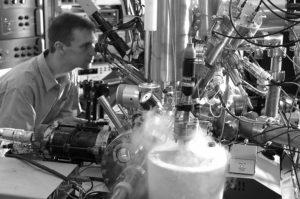ToF-SIMS and Laser Postionisation SNMSDesigned in collaboration with Prof. Nick Winograd’s group at Penn State University, KORE Technology Ltd. and Ionoptika Ltd.
|
|
| Origin : | KORE designed, UMIST/Penn State built |
| Primary Sources : | Ionoptika liquid metal source Au+/Au3+ or 69Ga+ projectile 25 keV beam energy at source Pulse width usually 15 – 20 ns Minimum spot size < 50 nmIonoptika fullerene source C60+ projectile 20 keV beam energy at source Minimum spot size < 1 µm |
| Sample Stage : | High stability cold stage, ~ 90 K Sample mounted horizontally Sample potential 2.5 kV |
| Mass Analyser : | Reflectron (two-stage) Mounted vertically Approximately 3 metre flight tube High transmission/collection optics |
| Detector : | Channelplate 2.7 kV gain 20 kV post-acceleration Two options; 1. 1 ns TDC, EG&G 2. Transient digitiser, Signatec |
| Charge Compensation : | Ionoptika electron flood source 10-1000 eV Pulsed between ion gun pulses |
| Laser postionisation : | Continuum PY61C-20 35 ps Nd:YAG 532, 355, 266 and 118 nm wavelengths available Coherent LegendElite USP Ti:S, 35 femtosecond |
| Special Features : | Freeze-fracture stage in the sample preparation chamber allows cryogenically stored samples to be analysed without atmospheric contamination. Retrospective imaging software allows offline imaging capability. Chemical imaging available in both SIMS and SNMS modes. |
| Projects Supported : | Single photon laser postionisation studies Multiphoton laser postionisation studies Biological (cell) analysis Self-assembled monolayers (and multilayers) Textile analysis |

